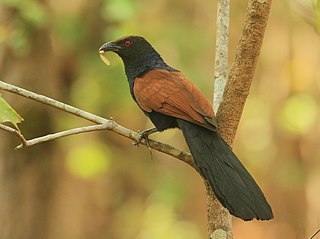
The greater coucal or crow pheasant, is a large non-parasitic member of the cuckoo order of birds, the Cuculiformes. A widespread resident in the Indian Subcontinent and Southeast Asia, it is divided into several subspecies, some being treated as full species. They are large, crow-like with a long tail and coppery brown wings and found in a wide range of habitats from jungle to cultivation and urban gardens. They are weak fliers, and are often seen clambering about in vegetation or walking on the ground as they forage for insects, eggs and nestlings of other birds. They have a familiar deep resonant call which is associated with omens in many parts of its range.
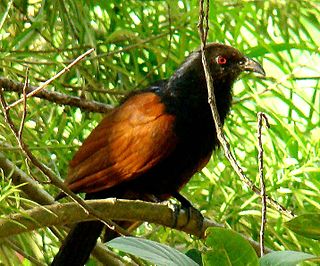
The green-billed coucal is a member of the cuckoos. It is endemic to Sri Lanka's wet zone and listed as Vulnerable on the IUCN Red List, as the small population declined due to forest destruction and fragmentation. It inhabits the tall rainforests of southwest Sri Lanka and nests in bushes. Its typical clutch is 2–3 eggs.

The Senegal coucal is a member of the cuckoo order of birds, the Cuculiformes, which also includes the roadrunners, the anis, and the hoatzin. It is a medium-sized member of its genus and is found in lightly-wooded country and savannah in central and southern Africa.

The black skimmer is a tern-like seabird, one of three similar birds species in the skimmer genus Rynchops in the gull family Laridae. It breeds in North and South America. Northern populations winter in the warmer waters of the Caribbean and the tropical and subtropical Pacific coasts, but the South American races make only shorter movements in response to annual floods which extend their feeding areas in the river shallows.

A coucal is one of about 30 species of birds in the cuckoo family. All of them belong in the subfamily Centropodinae and the genus Centropus. Unlike many Old World cuckoos, coucals are not brood parasites, though they do have their own reproductive peculiarity: all members of the genus are sex-role reversed, so that the smaller male provides most of the parental care. At least one coucal species, the black coucal, is polyandrous. Some species have the male investing more in incubation and parental care.

The yellow-legged buttonquail is a buttonquail, one of a small family of birds which resemble, but are unrelated to, the true quails. This family is peculiar in that the females are larger and more colourful than the males and are polyandrous.
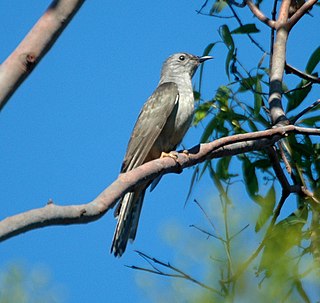
The brush cuckoo is a member of the cuckoo family.

The Andaman coucal or brown coucal is a species of non-parasitic cuckoo found in the Andamans, Coco and Table Islands. It is sometimes treated as a subspecies of the greater coucal. It is found mainly in forested habitats and thickly covered gardens.
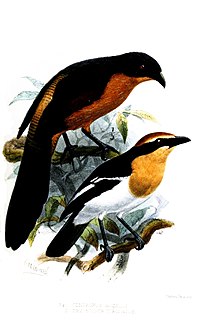
The Gabon coucal is a species of cuckoo in the family Cuculidae. It is mainly found in Gabon but also occurs in neighboring areas of Cameroon, Angola, the Central African Republic, the western Congo Basin and Equatorial Guinea.

The lesser coucal is a species of cuckoo in the family Cuculidae. It has a wide distribution range that overlaps with several other similar species. The habitat in which it is found is often marshy land with grass and tree cover. It is distinguished by its smaller size, less prominent bill, pale shaft streaks on the feathers of the head and back. It has a much longer claw on its hind toe and a distinct call. It is also among the few coucals that show season plumage differences but like in other coucals, the sexes cannot be distinguished in the field.

The coppery-tailed coucal is a species of cuckoo in the family Cuculidae. It is found in Angola, Botswana, the Democratic Republic of the Congo, Malawi, Namibia, Tanzania, Zambia, and Zimbabwe. It was first described by the German ornithologist Anton Reichenow in 1896.

The black coucal is a species of cuckoo in the family Cuculidae. It has a wide distribution in Africa south of the Sahara.

The black-throated coucal is a species of cuckoo in the family Cuculidae. It is found in West Africa in dense second growth along forest edge and grassy swamps. The subspecies found in northern and central Zaire is sometimes split as Neumann's coucal.

The blue-headed coucal is a species of cuckoo in the family Cuculidae. It is native to tropical central Africa where its typical habitat is swamps, river banks, forest edges and generally wet locations. It is a common bird with a wide range, and the International Union for Conservation of Nature has rated its conservation status as being of "least concern".

The pheasant coucal is a species of cuckoo in the family Cuculidae. It is found in Australia, Timor and New Guinea. Its natural habitats are subtropical or tropical moist lowland forests and subtropical or tropical mangrove forests. It has adapted well to canefields in northern Australia. The pheasant coucal is unusual among Australian cuckoos in that it incubates and raises its own young instead of laying its eggs in the nest of another species.

The white-browed coucal or lark-heeled cuckoo, is a species of cuckoo in the family Cuculidae. It is found in sub-Saharan Africa. It inhabits areas with thick cover afforded by rank undergrowth and scrub, including in suitable coastal regions. Burchell's coucal is sometimes considered a subspecies.

The Malagasy coucal or Madagascar coucal is a species of cuckoo in the family Cuculidae. It is found in Madagascar and in the Seychelles, where it occurs on Aldabra and was formerly present on Assumption Island and Cosmoledo. Its natural habitats are dense vegetation in subtropical or tropical moist lowland forests, mangrove forests, rough grassland, marshes and reedbeds.

The Philippine coucal is a species of cuckoo in the family Cuculidae. It is endemic to the Philippines.
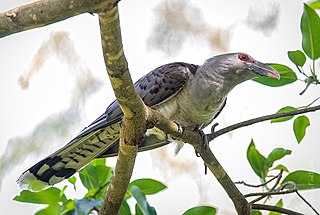
The channel-billed cuckoo is a species of cuckoo in the family Cuculidae. It is monotypic within the genus Scythrops. The species is the largest brood parasite in the world, and the largest cuckoo.





















